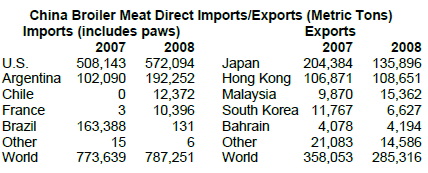



International Egg and Poultry Review
US - By the USDA's Agricultural Marketing Service (AMS). This is a weekly report looking at international developments concerning the poultry industry. This week's report is about the poultry situation in China.China Protests Poultry Import Provision in US Budget Legislation
The Ministry of Commerce of the People’s Republic of China posted a news release on 13 March 2009 concerning a “discriminative” US measure on Chinese poultry imports. Zhang Xiangchen, deputy permanent representative of the Chinese WTO mission, stated he received “a specific instruction from Beijing to express the serious concern of the Chinese government about the US Omnibus Appropriations Act of 2009.”
A provision in the US Spending bill – Section 727 of the Omnibus Appropriations Act 2009 - states “None of the funds made available in this Act may be used to establish or implement a rule allowing poultry products to be imported into the US from the People’s Republic of China.” The Act was approved by the U.S. House of Representative on 25 February and by the US Senate on 10 March.
On 11 March the Chinese WTO mission in Geneva sent a verbal note to the US WTO mission. According to the note, the US measure has triggered strong reactions in China, and the government is under increasing pressure from the poultry industries to “adopt related measures to poultry products imported from the United States.” The note also said that China would raise complaints to the WTO and maintain the right of further measures. The European Union lifted its six year ban on Chinese cooked poultry products in 2008.
According to figures from the Chinese Ministry of Commerce, China imported 580,000 tons of chicken products from the United States in 2008, accounting for 73.4 per cent of total chicken imports.
In 2007, the US Congress prohibited USDA from moving forward on plans to issue a proposed rule allowing China’s cooked poultry exports into the US under Section 733 of the 2008 Omnibus Appropriations Act.
Source: Ministry of Commerce of the People’s Republic of China; news wires
China Poultry and Poultry Products
FAS Beijing (Post) forecasts China’s broiler meat production will rise two per cent to 12.1 million metric tons (MMT) in 2009, down from earlier projections of 12.7 MMT. Production gains will be hampered by sluggish consumer demand as consumption of pork rises in response to sharply lower prices. Chinese pork production is recovering from the effects of blue ear disease in 2007 and 2008. Pork is the most popular animal protein and accounts for over 60 per cent of China’s total meat consumption.

Broiler consumption in 2009 is forecast to fall 3 per cent to 12.5 MMT, compared to an 11 per cent growth rate in 2008. Rising unemployment among migrant workers, a key market segment for low-priced chicken meat, will constrain demand. An estimated 20 million migrant workers became jobless in late 2008 due to the global economic slowdown.
Total Chinese broiler imports in 2008, including paws, rose 2% to more than one million tons. Excluding paws, imports of broiler meat declined 17 per cent to 399,000 tons. In 2009, US exports to China will face stronger competition from Brazil and Argentina because of lower prices from South America and due to China’s expected decision to resume direct imports from Brazil.

China’s broiler exports are forecast to decrease by 24 per cent to 215,000 MT due mainly to lower sales to Japan, which accounts for roughly half of total sales. Although the EU lifted its ban on Chinese poultry in late 2008, sale are just commencing. EU demand has been weak due mainly to comparatively high prices for Chinese chicken in the EU market.
Turkey meat imports are forecast to continue rising in 2009, up 10 per cent to more than 50,000 tons. The U.S. accounts for nearly 90 per cent of China’s turkey meat imports. China’s domestic turkey production is low, about 4,000 MT/year.

China’s total poultry egg production is forecast to grow steadily by over three per cent to 27.3 MMT base on a 4 per cent increase in the previous year.

After experiencing good profits in 2007 and the first half of 2008, slower economic growth and egg oversupplies pushed egg prices downward in the latter half of 2008. Current domestic egg prices are slightly below feed costs. China is a net table egg exporter with Hong Kong and Macau accounting for 90 per cent of total export sales. China’s exports in 2009 are expected to increase by five percent to 1.5 billion pieces.
Source: USDA/Foreign Agricultural Service, Attaché Report
Further Reading
| - | You can view the full report by clicking here. |











